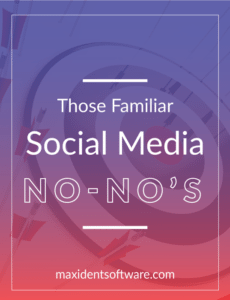
With Social Media Day having just passed (last Friday), you have probably heard it all: social media is the perfect marketing tool for your practice (it is!) Social media is one of the best ways to connect with your patients (Again, it is!) But is anyone going to tell you what not to do when it comes to using social media effectively? Because it’s Tuesday, and you’ve just come back from a long weekend to a ton of calls (either for missed appointments, cancelled appointments, or patients just wanting to make appointments who somehow forgot this last weekend was a long weekend), this blog post is going to focus on moments that might just make you crack a smile while providing you with some useful tips for managing your social media.
If you’ve been watching the news, you know what’s going on with the current president of the United States, and at times, you had to be laughing, but he has put forward a few important points about the impact of social media. Social media isn’t just about connecting with patients and peers; it’s also about creating a brand and a lot of the time, sending a message. However, with the current president’s help, I am going to arm you with 4 familiar no-no’s when it comes to using social media as a marketing tool in your dental practice.
Be careful with your spelling
Covfefe. If you don’t quite remember this, let me refresh: On Wednesday, May 31, midnight, the president tweeted “Despite the constant negative press covfefe” and left it like that until hours later. The Guardian reported that the tweet not being immediately deleted “was confusing to users who, in the hours between the two tweets, had indeed tried to work out what exactly Trump might have meant.” This is not his first big spelling no-no, either. Do you remember “tapp”? I sure do. The late shows had a hay day with it!
To deliver a professional message with any impact, you do have to be very careful when it comes to spelling. You can become easily discredited in the dental community if you let a spelling error slide. Always have a thesaurus handy if you’re unsure how to spell a word, and please, for the love of everything, try to avoid tweeting at midnight, lest you make a huge covfefe.
Don’t let a lawyer speak for you
This is incredibly specific, I know, but letting a voice that is clearly not your own deliver your message can definitely raise some eyebrows. As an example, take the current president’s tweet, regarding the Comey tapes:
“With all of the recently reported electronic surveillance, intercepts, unmasking and illegal leaking of information, I have no idea whether there are ‘tapes’ or recordings of my conversations with James Comey, but I did not make, and do not have any such recordings.”
In case you are unaware of how the current president forms his tweets, they do not sound this formal or this “legal.” They are usually very casual, heavily opinionated and overflowing with hashtags. And to no one’s surprise, everyone noticed. The point I’m making with this is once you’ve developed an identity and voice as a writer, it’s incredibly important not to stray from that voice or those people who follow you are definitely going to take notice and might even start questioning your authenticity.
Keep it short
If you’re familiar with Twitter, you are also familiar with their word limit per tweet. 140 characters. That’s it. Go any further and you will have to tweet again, and again, and again. Every once in awhile, the current president will do just that, sending a Tweet storm that is more convoluted than meaningful.
In order to create a concise and meaningful message, keep it to one tweet or one Facebook status. I understand that Facebook allows more room for a more wordy message, but more words doesn’t make it more meaningful, if anything the message will just get lost in all the unnecessary words and the message might just get slapped with another familiar message tl/dr (too long, don’t read).
Try not to contradict yourself
The thing is, minds change and what we agreed with once, we might no longer agree with now. But it is incredibly frustrating for any patient or any human being for that matter to understand a message if it keeps changing. If your point of view changes, explain why it’s changed and provide evidence to back it up. You do not want to be made a fool if you’re saying one thing and your message is saying something else. Chinese hoax, anyone?
If you have more social media no-no’s you want to share, please add them to our comment section below.
Resources:



